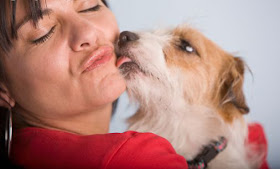
Here is the doggy football line-up:
DEFENSE:
Safety – These guys are hard hitters, but they can also run very fast. - Dalmatian, Samoyed
Linebacker – Linebackers are big and fast, like a Mastiff, Bullmastif, Bull Dog, German Shepherd, Doberman, Rottweiler, St. Bernard, Newfoundland, Akita, Alaskan Malamutes, Airdeale Terriers, Weimaraners, Borzois and Giant Schnauzers.
Cornerback – These guys are fast, very athletic and can really jump. (It's their job to try to swat the ball away or intercept it when it's thrown.) – Australian Shepherd, Australian Cattle Dog, Siberian Husky, Rodesian Ridgeback,
Defensive End – These tough guys are big and fast because their job is "containment". Their job is to attack the passer or stop the runner. - Pit Bull, Labrador retriever, Great Dane, Great Pyrenees, Gordon Setter, Dogo Argentino
Tackle – Players at this position have to get by the players that are blocking them and rush the passer. They're big and strong. - Saint Bernard, Bernese Mountain Dog
OFFENSE:
Quarterback – This guy calls all the shots. He's fast. He can scramble. He's smart. He has to read what's going on and react quickly to pass, hand off the ball or run it himself. – Labrador Retriever, Golden Retriever (some of them), German Shepherd, Collie,
Wide Receiver – These dogs are speedy and they specialize in catching passes. They need to outrun the guys that are blocking them and get open for a pass. - Greyhound, Standard Poodle, Boxer, Chesapeake Bay Retriever, Whippet
Tackle – These big guys block both running and passing plays. - Saint Bernard, Bernese Mountain Dog,
Guard – These big tough guys are also blockers who really get the job done. - Pit Bull, Akita, Shar Pei, Chow-chow
Center – This guy snaps the ball to the quarterback, then blocks. -Komondorok , Old English Sheepdog
Tight End – These guys are a "hybrid" of sorts, kind of a mix between a blocker and a pass receiver. A good tight end has to be big and fast. - Pit Bull, Labrador retriever,
Running Back – fast and sneaky – Border Collie, Jack Russell, Greyhound,
Fullback – This guy does it all. He's a power runner, a blocker and a short receiver. This is the guy that who creates a path for the running back to break through and really run the ball. – Boxer, Belgian Sheepdog and Chesapeake Bay Retriever
Kicker / Punter – Kicker – This guy is a specialist with a very specific talent. He is the guy with the "leg". He's not as big, but he knows how to kick the ball accurately and for a great distance. - Jack Russell Terrier, Shetland Sheepdog, and bull terrier
Gunner – This guy is also very fast. He only plays during kick-offs and punts. It's his job to run down the field very fast to tackle the guy who catches the punt or the kick. That means he has to be very quick, but also strong. – American Staffordshire Terrier
OTHER:
Coach – He is a strategist who knows everything there is to know about the sport. He has played the game himself in the past, but now he runs the show. - Bulldog, Boston Terrier ,Irish Setter, Pointer
Cheerleader – All glitz and glam, these "babes" put on a show of their own while promoting team spirit. - Poodle, Bichon, Rat Terrier, Pomeranian, Yorkshire Terrier, Shih Tzu, Maltese, Pekingese, Lhasa Apso, Chinese Crested

















